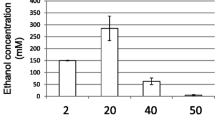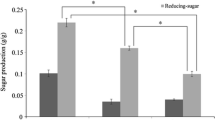Abstract
Several species of seaweeds contain higher amounts of polysaccharides and low lignin. These species can be sources for bioethanol production and can be utilized for other biochemical production. In Thailand, large amounts of the red seaweeds Gracilaria fisheri and G. tenuistipitata can easily grow in effluents from aquaculture ponds and are used for wastewater treatment. This study was done to assess the potential substrates from these two Gracilaria species to produce ethanol. Different concentrations of substrate from each species (20–200 mg) were pretreated with 1 M H2SO4 at 95 °C for 150 min. The optimal pretreatment was 60 mg of substrate treated with 1 M H2SO4 at 95 °C for 150 min. This condition gave the highest amount of fermentable sugars in both Gracilaria species. Under these conditions, G. fisheri showed a higher catalytic efficiency (E = 5.2) than G. tenuistipitata (E = 4.1). Ethanol fermentation was performed by using the yeast strain Saccharomyces cerevisiae TISTR 5339. The ethanol produced from the G. tenuistipitata fermentation had the highest yield, producing 0.19 g ethanol g−1 glucose, whereas that of G. fisheri yielded 0.16 g ethanol g−1 glucose. This study suggests that the biomass of G. fisheri and G. tenuistipitata from a marine aquaculture system is a potential source for ethanol production.





Similar content being viewed by others
References
Aditiya HB, Mahlia TMI, Chong WT, Nur H, Sebayang AH (2016) Second generation bioethanol production: a critical review. Renew Sust Energ Rev 66:631–653
Chandel AK, Kapoor RK, Singh AK, Kuhad RC (2007) Detoxification of sugarcane bagasse hydrolysate improves ethanol production by Candida shehatae NCIM 3501. Bioresour Technol 98:1947–1950
Chirapart A, Praiboon J, Puangsombat P, Pattanapon C, Nunraksa N (2014) Chemical composition and ethanol production potential of Thai seaweed species. J Appl Phycol 26:979–986
Chirapart A, Praiboon J, Ruangchuay R, Notoya M (2015) Sources of marine biomass. In: Kim S-K, Lee C-G (eds) Marine bioenergy: trends and developments. CRC Press, Boca Raton, pp 15–44
Esteghalalian A, Hashimoto AG, Fenske JJ, Penner MH (1997) Modeling and optimization of the dilute-sulfuric-acid pretreatment of corn stover, poplar and swithgrass. Bioresour Technol 59:129–136
Girio FM, Fonseca C, Carvalheiro F, Duarte LC, Marques S, Bogel-Lukasik R (2010) Hemicelluloses for fuel ethanol: a review. Bioresour Technol 101:4775–4800
Goh CS, Lee KT (2010) A visionary and conceptual macroalgae-based third-generation bioethanol (TGB) biorefinery in Sabah, Malaysia as an underlay for renewable and sustainable development. Renew Sust Energ Rev 14:842–848
Goh CS, Tan KT, Lee KT, Bhatia S (2010) Bio-ethanol from lignocellulose: status, perspectives and challenges in Malaysia. Bioresour Technol 101:4834–4841
Herrera A, Téllez-Luis SJ, González-Cabriales JJ, Ramírez M, Vázquez JA (2004) Effect of hydrochloric acid concentration on the hydrolysis of sorghum straw at atmospheric pressure. J Food Eng 63:103–109
Jambo SA, Abdulla R, Azhar SHM, Marbawi H, Gansau JA, Ravindra P (2016) A review on third generation bioethanol feedstock. Renew Sust Energ Rev 65:756–769
Jang SS, Shirai Y, Uchida M, Wakisaka M (2012) Production of mono sugar from acid hydrolysis of seaweed. Afr J Biotechnol 11:1953–1963
Jeong G-T, Park D-H (2010) Production of sugars and levulinic acid from marine biomass Gelidium amansii. Appl Biochem Biotechnol 161:41–52
Jeong GT, Kim SK, Park DH (2013) Detoxification of hydrolysate by reactive-extraction for generating biofuels. Biotechnol Bioprocess Eng 18:88–93
Kang KE, Park DH, Jeong GT (2013) Effects of inorganic salts on pretreatment of Miscanthus straw. Bioresour Technol 132:160–165
Kawaroe M, Sari DW, Hwangbo J, Santoso J (2015) Optimum fermentation process for red macroalgae Gelidium latifolium and Gracilaria verrucosa. J Eng Technol Sci 47:674–687
Kim JK, Yarish C (2014) Development of a sustainable land-based Gracilaria cultivation system. Algae 29:217–225
Kim SW, Hong C-H, Jeon S-W, Shin H-J (2015) High-yield production of biosugars from Gracilaria verrucosa by acid and enzymatic hydrolysis processes. Bioresour Technol 196:634–641
Kim JK, Yarish C, Hwang EK, Park M, Kim Y (2017) Seaweed aquaculture: cultivation technologies, challenges and its ecosystems services. Algae 32:1–13
Kumar S, Gupta R, Kumar G, Sahoo D, Kuhad RC (2013) Bioethanol production from Gracilaria verrucosa, a red alga, in a biorefinery approach. Bioresour Technol 135:150–156
Lahaye M, Rochas C, Yaphe W (1986) A new procedure for determining the heterogeneity of agar polymers in the cell wall of Gracilaria spp. (Gracilariaceae, Rhodophyta). Can J Bot 64:579–585
Meinita NDM, Jeong GT, Hong YK (2012) Comparison of sulfuric acid and hydrochloric acids as catalysts in hydrolysis of Kappaphycus alvarezii (cottonii). Bioprocess Biosyst Eng 35:123–128
Meinita MDN, Marhaeni B, Winanto T, Jeong G-T, Khan M, Hong Y-K (2013) Comparison of agarophytes (Gelidium, Gracilaria and Gracilariopsis) as potential resources for bioethanol production. J Appl Phycol 25:1957–1961
Meinita MDN, Marhaeni B, Winanto T, Setyaningsih D, Hong YK (2015) Catalytic efficiency of sulfuric and hydrochloric acid for hydrolysis of Gelidium latifolium (Gelidiales, Rhodophyta) in bioethanol production. J Ind Eng Chem 27:108–114
Nguyen TH, Ra CH, Sunwoo IY, Jeong GT, Kim SK (2016) Evaluation of galactose adapted yeasts for bioethanol fermentation from Kappaphycus alvarezii hydrolyzates. J Microbiol Biotechnol 26:1259–1266
Nunraksa N, Praiboon J, Puangsombat P, Chirapart A (2015) Effects of hydrochloric acid pretreatment on ethanol yield of the agarophyte, Gracilaria tenuistipitata. Kasetsart Univ Fish Res Bull 39:38–47
Praiboon J, Chirapart A, Akakabe Y, Bhumibhamond O, Kajiwara T (2006) Physical and chemical characterization of agar polysaccharides extracted from Thai and Japanese species of Gracilaria. Sci Asia 32:11–17
Ra CH, Choi JG, Kang C-H, Sunwoo IY, Jeong G-T, Kim S-K (2015) Thermal acid hydrolysis pretreatment, enzymatic saccharification and ethanol fermentation from red seaweed, Gracilaria verrucosa. Microbiol Biotechnol Lett 43:9–15
Ruangchuay R, Lueangthuvapranit C, Nuchaikaew M (2010) Cultivation of Gracilaria fisheri (Xia & Abbott) Abbott, Zhang & Xia (Gracilariales, Rhodophyta) in abandoned shrimp ponds along the cost of Pattani Bay, southern Thailand. Algal Resour 3:185–192
Silva Lora EE, Escobar Palacio JC, Rocha MH, Grillo Reno ML, Venturini OJ, Almazandel Olmo O (2011) Issues to consider, existing tools and constraints in biofuels sustainability assesments. Energy 36:2097–2110
Taherzadeh MJ, Karimi K (2007) Acid-based hydrolysis processes for ethanol from lignocellulosic materials: a review. BioResour 2:472–499
Wu F-C, Wu J-Y, Liao Y-J, Wang M-Y, Shih I-L (2014) Sequential acid and enzymatic hydrolysis in situ and bioethanol production from Gracilaria biomass. Bioresour Technol 156:123–131
Yarnpakdee S, Benjakul S, Kingwascharapong P (2015) Physico-chemical and gel properties of agar from Gracilaria tenuistipitata from the lake of Songkhla, Thailand. Food Hydrocoll 51:217–226
Acknowledgements
Special thanks to anonymous reviewers whose remarks helped to improve this paper.
Funding
This research was partly supported by the Graduate Scholarship “72 years Scholarship Kasetsart University.”
Author information
Authors and Affiliations
Corresponding author
Rights and permissions
About this article
Cite this article
Nunraksa, N., Rattanasaensri, S., Praiboon, J. et al. Comparison of ethanol production from Gracilaria fisheri and Gracilaria tenuistipitata cultivated in aquaculture system in Thailand. J Appl Phycol 30, 3319–3325 (2018). https://doi.org/10.1007/s10811-018-1536-9
Received:
Revised:
Accepted:
Published:
Issue Date:
DOI: https://doi.org/10.1007/s10811-018-1536-9




